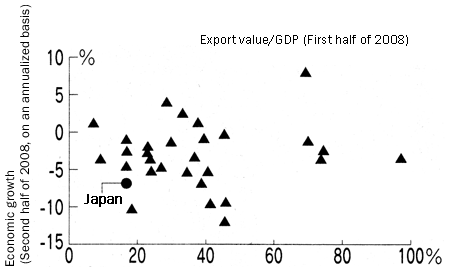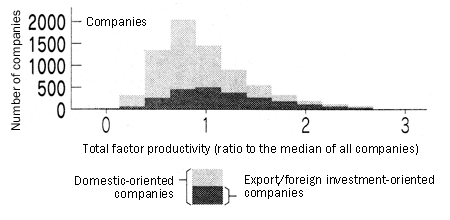In the recent global financial and economic crises, the contraction in the gross domestic product (GDP) of Japan was the largest among developed nations. The main reason for the decline was a large fall in exports. In the first half of 2009, the value of Japanese exports plunged 43% year on year and as a result, many economists in Japan are calling for an end to a dependence on exports in favor of expanding domestic demand. This paper argues the opposite; taking the position that strengthening Japan's dependence on exports will increase stability in times of crisis and contribute to economic growth.
In fact, Japan's dependence on exports is already low compared to other developed nations. The percentage of exports to GDP is the second lowest, after the United States, among the member countries of the Organization for Economic Co-operation and Development (OECD), and exporting companies (including those with low export volumes) account for approximately 30% of all mid- or large-sized companies in Japan, which is considerably lower than in Europe, where the ratio is more than 50%. In addition, looking at OECD nations on the whole, there is nothing to suggest that the higher the dependence on exports before the crisis, the larger the fall in growth after the crises ( figure 1 ). This result suggests that it is difficult to simply conclude that the more dependent a nation is on exports, the more susceptible it becomes to an overseas economic crisis.

(Source)Website of the OECD Statistics Directorate
* * *
So, why was the fall in exports so noticeable in Japan? A number of factors have been cited for the decline, including: the fact that export industries in Japan concentrate on consumer durables sectors such as automobiles and electrical machinery (exports of goods whose purchase cannot be postponed, such as pharmaceuticals, did not decline); and the shock from the crises was exacerbated for Japanese companies because of their extensive production networks in Asia. This paper also points to another, somewhat surprising reason for the large fall in Japanese exports: the fact that Japanese companies with high productivity were not necessarily involved in exporting.
Intuitively, one presumes that highly productive companies would export and the latest trade theories of Professor Marc Melitz and his fellow scholars at Princeton University explain that this is because exporting requires an initial investment, such as marketing in the destination country. How does this compare with reality? A research project, "Study on International Trade and Firms," headed by Professor Ryuhei Wakasugi (Kyoto University) and his fellow researchers at the Research Institute of Economy, Trade and Industry (RIETI), analyzed large and midsize companies in the manufacturing industry, using firm-level data from business surveys conducted by the Ministry of Economy, Trade and Industry.

(Source)Prepared based on data used in "The Internationalization of Japanese Firms: New Findings Based on Firm-Level Data" by WAKASUGI Ryuhei et al. (RIETI Discussion Paper No. 08-E-036)
Figure 2 shows the distribution of total factor productivity (TFP), a firm-level productivity indicator, by dividing Japanese companies into domestic-oriented companies that neither export nor make direct foreign investment and global companies that either export or make direct foreign investment. Although it is true that global companies have higher productivity than domestic-oriented companies on average, it is also observed that the distributions of these two types of companies overlap in a significant way. In other words, many companies confine their operations to Japan even though their productivity is high. Looking more closely, these companies exist regardless of the industries or scale of the firm. In contrast, many companies are globalized although their productivity is not necessarily high, and these companies tend to have a large number of employees. This fact applies to each industry and even if labor productivity is used as a productivity indicator.
Moreover, when conducting a quantitative analysis on determinants of exports and direct foreign investment for each company using a quantitative model (mixed logit model) that is able to examine the effect of enterprise characteristics that do not appear in the data, it is revealed that companies with high productivity indeed tend to engage in exports and direct foreign investment. However, the degree of the effect is insignificant, and it is expected that even if the productivity of an average domestic-oriented company were to double, the likelihood that the company would engage in exports or direct foreign investment increases only marginally by approximately 0.01%.
Other factors such as the size of the company and the flow of information from other global companies in the same region also influence globalization, although the effect is also minimal. Instead, inertia based on past experience has a very large impact. In other words, companies that are already globalized tend to remain that way, even if productivity and size decline significantly. This implies that the initial investment is an important factor in determining globalization. Unobserved enterprise characteristics (for example, the degree of risk aversion and information-gathering capacity specific to companies) also have a large quantitative effect.
Although these results conform to the results of research done in other countries using their own firm-level data, in general, the smaller effect of productivity and the stronger inertia in Japan stand out when compared with other countries.
* * *
Let us summarize these results in a narrative style. Although Company A did not have particularly strong technical capabilities, it began exporting at the behest of management and managed to successfully expand its overseas networks. Since then, Company A has managed to survive on the strength of its networks, despite its low productivity. In contrast, Company B, which competes with Company A in Japan, has impressive technical capabilities and sufficient competitiveness to compete in overseas markets but is reluctant to export as management is unfamiliar with overseas markets and is concerned about the risks. In addition, Company B finds it increasingly difficult to take the plunge with exports for fear of having to compete in overseas markets with Company A, which is already operating in foreign countries.
In fact, there are many "hidden dragons" like Company B in Japan. As many as 2,000 domestic-oriented companies have a higher TFP than the average for export and foreign investment-oriented companies, accounting for 27% of all domestic-oriented companies. On the other hand, there are more exporting companies like Company A in Japan than overseas. Professor Takeo Hoshi at the University of California, San Diego, calls a company that survives with additional loans from banks despite having negative net worth a "zombie company." To extend the term, companies like Company A can be called "zombie exporters."
If a global economic crisis occurs under these circumstances, low quality products made by zombie exporters with low technical capabilities will be hard hit. Perhaps this is one of the reasons why Japanese exports declined so sharply. If Japanese hidden dragons had exported their products, demand might not have fallen so sharply, because they would have sold high quality products at low prices, which could have underpinned the steep decline in exports that accompanied the economic crisis.
If this is the case, increasing Japan's export dependence by awakening the hidden dragons would in fact contribute to the stability of the Japanese economy. Just as famed Chinese strategist Zhuge Liang, who was called the "hidden dragon" at that time, only gained acclaim after three visits by Liu Bei, policy support is needed to encourage the hidden dragons in Japan to cross the sea.
While policies such as moving forward with the negotiations of the World Trade Organization, expanding the scope of free trade agreements and official development assistance, and providing information about overseas markets are all certainly necessary, it is also essential that the Japanese government conveys a clear message that it will aim to achieve growth through outward-looking globalization rather than through an inward-looking orientation, so that hidden dragons will be able to demonstrate their animal spirits.
* * *
Companies that should globalize are not limited to hidden dragons. Many empirical studies show that corporate productivity rises through exports and foreign investment. For example, Dr. Satoshi Shimizutani, a senior research fellow at the Institute for International Policy Studies (IIPS), and the author have shown that innovative research and development at overseas subsidiaries will improve the productivity of the parent company in Japan. Professor Kyoji Fukao and his fellow scholars at Hitotsubashi University have also shown empirically that productivity in domestic demand-oriented industries such as agriculture and services is lower than that in the manufacturing sector. Nevertheless, according to Associate Professor Yukiko Ito at Tokyo Gakugei University, globalization in the service industry has a larger effect of improving productivity than in the manufacturing industry.
It is thus of decisive importance for the stability and long-term growth of the economy that Japanese companies, including those in domestic demand-oriented industries, continue to globalize. As Japan ranks near the bottom of developed nations in terms of both exports and inward and outward direct foreign investment, there remains plenty of room for globalization. If the government continues to take steps to encourage inward-looking industries, such as a return to public investment under the banner of expanding domestic demand, Japan will not be able to unleash the potential of the hidden dragons or the country itself.
This also applies to the world at large. If the main cause of Japan's "Two Lost Decades" is a decline in productivity, as Professor Fumio Hayashi at the University of Tokyo explains, then the only way to recover from the global recession is for countries to stimulate one other through further globalization. Japanese companies could play a large role in this process if they pursue outward-looking policies.
* Translated by RIETI with minor revisions.
July 29, 2009 Nihon Keizai Shimbun


